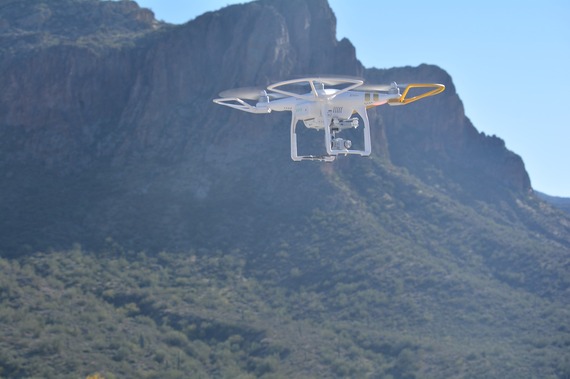In a recent economic report by the Association for Unmanned Vehicle Systems International (AUVSI), drones will have an economic impact in the first three years of more than $13.6 billion, escalating beyond $82 billion and potentially creating more than 100,000 jobs by the year 2025. According to Mario Mairena, AUVSI's senior government relations manager, commercial drones had been widely used in countries like Canada, United Kingdom, Australia and Japan. He said that Japan farmers have been utilizing unmanned helicopters in precision irrigation, crop inspection, pesticide application and fertilizer.
I remembered an article I wrote before about how Robotics will play a crucial part in solving the big problems of our tomorrow and why a number of companies are united in forging robotics engineering. To get a better insight of this "feudal" industry, I decided to share wits with the CEO and Co-Founder of the Unmanned Autonomous Vehicle Systems Association (UAVSA) Keith Kaplan. UAVSA is the first and largest commercial drone association.
DD: As co-founder and CEO of UAVSA, the first and largest commercial drone association solely dedicated to the commercial global drone community, what are your plans for this year to achieve UAVSA objectives. Please rank the top 3 plans.
KK: As we move into the second year of the UAVSA we are very excited to expand the association globally, with the addition of Asia and Europe to the International Drone Expo and Business Conference Schedules. As our membership continues to grow, we are forging relationships with leading drone professionals regionally to create UAVSA chapters that will offer face to face community and expand the service offered to the community. Our top 3 plans are:
1. Grow Internationally
2. Expand Service Offerings
3. Continue to integrate and connect general aviation and robotic aviation
DD: Please elaborate on the work you do with drones and how cyber security and integration of cyber autonomy affect our everyday lives.
KK: The major work that I do day to day is at the highest levels of research, collaboration, hypothesis, and formulation with some of the greatest minds in technology and engineering. We are creating opportunities for the education and commercialization of emerging technologies and products in Robotics, Artificial Intelligence, Cyber Security, Computer Science, and Engineering; and how these apply to workforce development, Commercialization, and human interaction.
DD: Are you also into drone development yourself? If yes, please share a few of the products you have developed.
KK: We have developed a complete drone advertising platform.We have also incubated the Tesla Drone Consultancy.
The Tesla Foundation Drone Consultancy was incubated by the Tesla Foundation to help industry, government agencies, as well as search and rescue organizations navigate the technological, logistical, legal, and operational challenges of the integration of aerial robotics.
DD: One drug company has a product that can carry the human passenger in air conditioning with luggage. What's your comment on that? What will be the top three obstacles for products to be commercialized. How successful do you think it will be in the US and by what year?
KK: This is only a precursor to the flying car, or Personal Robotic Transportation Pod (PRTP). I believe this is a foreseeable future, but the technology, legislation, and traffic management systems must first be established and working under the current challenges we face with the integration of aerial robotics (Drones) into our National Air System (NAS), before we can address the same issues integrating PRTP's. Ultimately the car companies and or startups that will be purchased by car companies will lead this technology into fruition. Oftentimes, we overlook that car and aircraft companies are technology firms.
Keith also shared his thoughts on a recent article published in time.com and originally appeared in fortune.com about Google Drones, eventually becoming a delivery system. According to him, the biggest issue preventing the proliferation of this initiative is not the technical aspect, but the disruption of general aviation on a global scale. There are issues that we have to address in terms of the consistent legislation, air traffic control and the metadata to comply with the legal and insurance concerns. The general businesses and consumers must accept robotics as part of our everyday lives.
He said, "It is also important to consider our responsibility to manage this integration with ethics, always considering the privacy and security of individuals, to put in place the systems of education of our young and the transitioning workforce, and to manage Artificial Intelligence for the betterment of mankind."
In the Second International Drone Exhibition (IDE) held last December 2015, the Aircraft Owners and Pilots Association (AOPA) and the Experimental Aircraft Association (EAA) participated for the time and welcomed the drone community. Keith Kaplan said that "DJI for the first time ever exhibited what drones and virtual reality can accomplish with the advent of "Virtual Tourism", a truly jaw dropping display of creativity and technology at its best. This just scratches the surface of what aerial robotics and virtual reality (VR) are going to be able to accomplish. The combination of VR and drones is just beginning to be explored, and as VR garners greater acceptance we will see many applications that combine the two technologies."
The international drone community had showcased incredible technological advancements in just one year. What was to many mere "prototypes", but in only one year were exhibiting complete "plug and play" drone systems ready to complete major motion picture cinematographic aerials, provide Lidar and Infrared imagery for data collection, first person view (FPV) for virtual flying, racing, and situational awareness, and the aerial mapping of an entire city - down to the centimeter. The pace of the Drone industry's innovations are moving at lightning speed. There are no signs of slowing any time soon. As Keith Kaplan says, "The past week will seem like "the old days" due to the fast pace work each week."
The first ever world's commercial droneport and teaching facility is being constructed in Boulder City, NV. Dubbed as The Aerodrome Project, it is "funded, working and building." Privately owned but open to the public, the 50-acre droneport conducts trainings on all aspects of commercial drones, which include FAA repairman and pilot certification training.
Yes, these are exciting times. Using drones to deliver groceries, or even transporting people to lessen traffic, is indeed mind-blowing and impressive. For the investment community, the opportunities to profit are massive. But as Uncle Ben said to Spiderman, "with great power comes great responsibility"; we must use Robotics wisely and for the advancement of our society.
Image credit: pixabay.com

